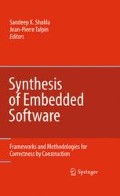Abstract
Safety critical applications require embedded software that can guarantee deterministic output and on time results during execution. Synchronous programming languages are by nature focused on providing the programmer with deterministic output at fixed points in time [1, 2]. Synchronous programming languages such as Esterel [3], LUSTRE [4], SIGNAL [5], etc., have successfully generated sequential software for embedded applications targeting avionics, rail transport, etc. The underlying formalism of these languages is robust and the associated software tools provide correctness preserving refinement from the specification to implementation. But even within the class of synchronous programming languages, there are very distinctive Models of Computation (MoC) [6]. Esterel and LUSTRE use an external global tick (or global clock) as reference for events that occur in the system. SIGNAL has an entirely different Model of Computation, where no assumptions are made on the global tick while designing the system. Each event has its own tick associated with it and for compilation the analysis of the specification would have to yield a totally ordered tick from the specification. In its absence, a variable (also known as signal) is constructed which has an event happening in synchrony with every event occurring in the system. This signal can be viewed as a root clock of the system with a hierarchical tree structure relating it with every other signal. Since events can occur at each signal at different rates, this MoC is also known as polychronous or multi-rate.
Access this chapter
Tax calculation will be finalised at checkout
Purchases are for personal use only
References
N. Halbwachs. Synchronous programming of reactive systems. Kluwer, Dordrecht, 1993.
E. A. Lee and A. Sangiovanni-Vincentelli. A framework for comparing models of computation. IEEE Transactions on Computer-Aided Design of Integrated Circuits and Systems, 17(12):1217–1229, 1998.
G. Berry and G. Gonthier. The ESTEREL synchronous programming language: design, semantics, implementation. Science of Computer Programming, 19(2):87–152, 1992.
N. Halbwachs, P. Caspi, P. Raymond, and D. Pilaud. The synchronous data flow programming language LUSTRE. Proceedings of the IEEE, 79(9):1305–1320, 1991.
P. L. Guernic, T. Gautier, M. L. Borgne, and C. L. Maire. Programming real-time applications with Signal. Proceedings of the IEEE, 79(9):1321–1336, 1991.
A. Benveniste, P. Caspi, S. Edwards, N. Halbwachs, P. Le Guernic, and R. de Simone. The synchronous languages twelve years later. Proceedings of the IEEE: Special Isssue on Modeling and Design of Embedded Systems, 91(1):64–83, 2003.
G. Berry and E. Sentovich. Multiclock esterel: correct hardware design and verification methods. Lecture Notes in Computer Science, volume 2144, pages 110–125. Springer, Berlin, 2001.
T. Austin, D. Blaauw, T. Mudge, and K. Flautner. Making typical silicon matter with razor. Computer, 37(3):57–65, 2004.
M. Blum and S. Kannan. Designing programs that check their work. In Proc. of the 21st ACM Symposium on Theory of Computing, pages 86–97, New York, NY, USA, 1989. ACM.
Synfora Inc. Esterel Studio EDA Tool. http://www.synfora.com/products/esterelstudio.html.
ESTEREL Technologies. The SCADE suite. http://www.esterel-technologies.com/products/scade-suite.
ESPRESSO Project, INRIA. The Polychrony toolset. http://www.irisa.fr/espresso/Polychrony.
T. Gautier, P. Le Guernic, and L. Besnard. SIGNAL: A declarative language for synchronous programming of real-time systems. In Proc. of a Conf. on Functional Programming Languages and Computer Architecture, pages 257–277, 1987.
T. P. Amagbegnon, L. Besnard, and P. Le Guernic. Implementation of the data-flow synchronous language signal. In ACM Symp. on Prog. Languages Design and Implementation (PLDI’95), volume 1, pages 163–173, 1995.
D. Nowak. Synchronous structures. Information and Computation, 204(8):1295–1324, 2006.
B. A. Jose and S. K. Shukla. An alternative polychronous model and synthesis methodology for model-driven embedded software. In Asia and South Pacific Design Automation Conference (ASP-DAC 2010), pages 13–18, Jan. 2010.
B. A. Jose, S. K. Shukla, H. D. Patel, and J-P Talpin. On the multi-threaded software synthesis from polychronous specifications. In Formal Models and Methods in Co-Design (MEMOCODE), Anaheim, CA, USA, pages 129–138, Jun. 2008.
B. Houssais. The synchronous programming language signal. a tutorial. Technical report, IRISA ESPRESSO project, 2004.
B. A. Jose, L. Stewart, J. Pribble, and S. K. Shukla. Technical report on EmCodeSyn models: STARMAC and producer–consumer examples. Technical Report 2009-02, FERMAT Lab, Virginia Tech, 2009.
B. A. Jose, J. Pribble, Lemaire Stewart, and Sandeep K. Shukla. EmCodeSyn: a visual framework for multi-rate data flow specifications and code synthesis for embedded applications. In 12th Forum on Specification and Design Languages (FDL’09), pages 1–6, Sept. 2009.
P. Jackson and J. Pais. Computing prime implicants. In CADE-10: Proc. of the Tenth Intl. Conf. on Automated Deduction, pages 543–557, New York, NY, USA, 1990. Springer, New York.
J. de Kleer. An improved incremental algorithm for computing prime implicants. In Proc. AAAI-92, pages 780–785, San Jose, CA, USA, 1992.
A. Matusiwicz, N. Murray, and E. Rosenthal. Prime implicate tries. In Proc. of 18th Intl. Conf. on Automated Reasoning with Analytic Tableaux and Related Methods, Oslo, Norway, 2009. Lecture Notes in Computer Science, volume 5607, pages 250–264. Springer, Berlin, 2009.
STARMAC project Group. The Stanford testbed of autonomous rotorcraft for multi-agent control overview. http://www.hybrid.stanford.edu/starmac/overview.
B. A. Jose, H. D. Patel, S. K. Shukla, and J.-P. Talpin. Generating multi-threaded code from polychronous specifications. Electronic Notes on Computer Science, 238(1):57–69, 2009.
B. A. Jose, J. Pribble, and S. K. Shukla. Faster software synthesis using actor elimination techniques for polychronous formalism. In 10th International Conference on Applications of Concurrency to System Design (ACSD 2010), June 2010.
Author information
Authors and Affiliations
Corresponding author
Editor information
Editors and Affiliations
Rights and permissions
Copyright information
© 2010 Springer US
About this chapter
Cite this chapter
Jose, B.A., Shukla, S.K. (2010). MRICDF: A Polychronous Model for Embedded Software Synthesis. In: Shukla, S., Talpin, JP. (eds) Synthesis of Embedded Software. Springer, Boston, MA. https://doi.org/10.1007/978-1-4419-6400-7_6
Download citation
DOI: https://doi.org/10.1007/978-1-4419-6400-7_6
Published:
Publisher Name: Springer, Boston, MA
Print ISBN: 978-1-4419-6399-4
Online ISBN: 978-1-4419-6400-7
eBook Packages: EngineeringEngineering (R0)

